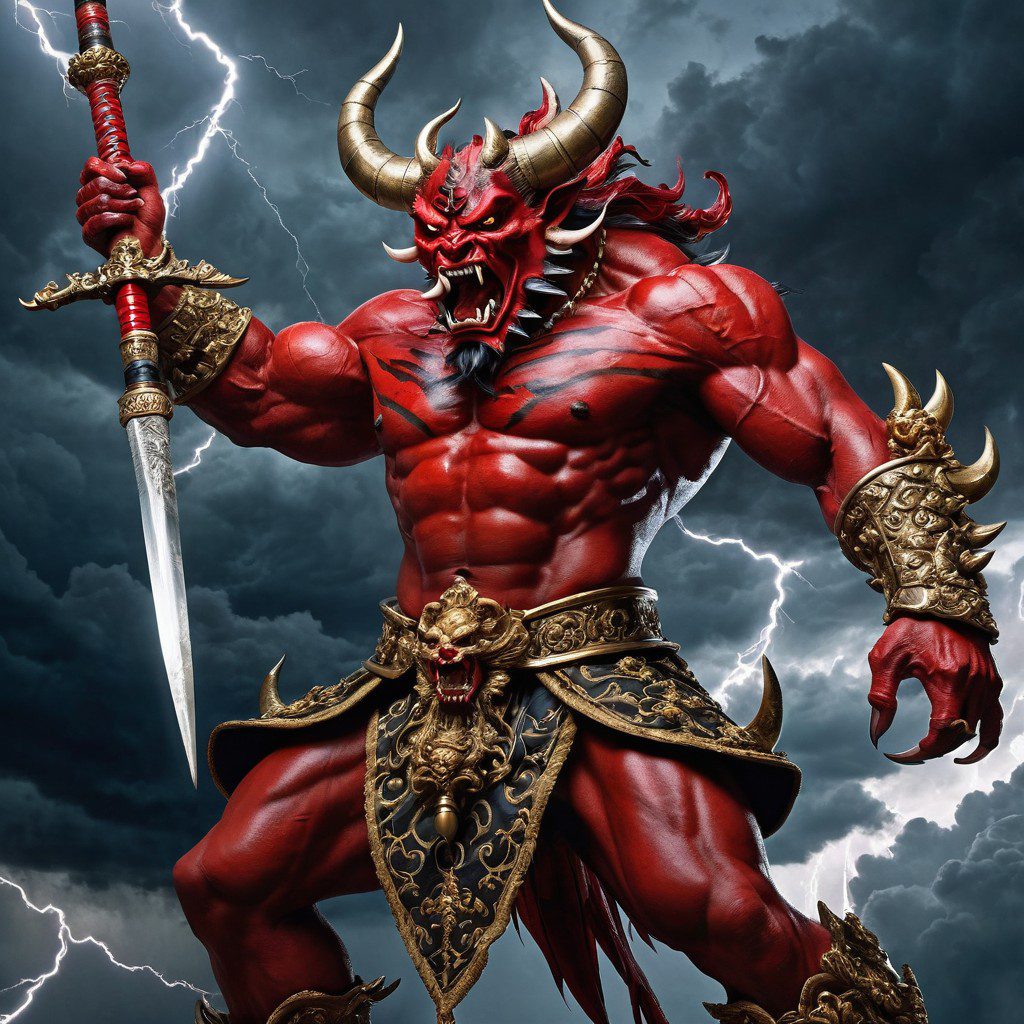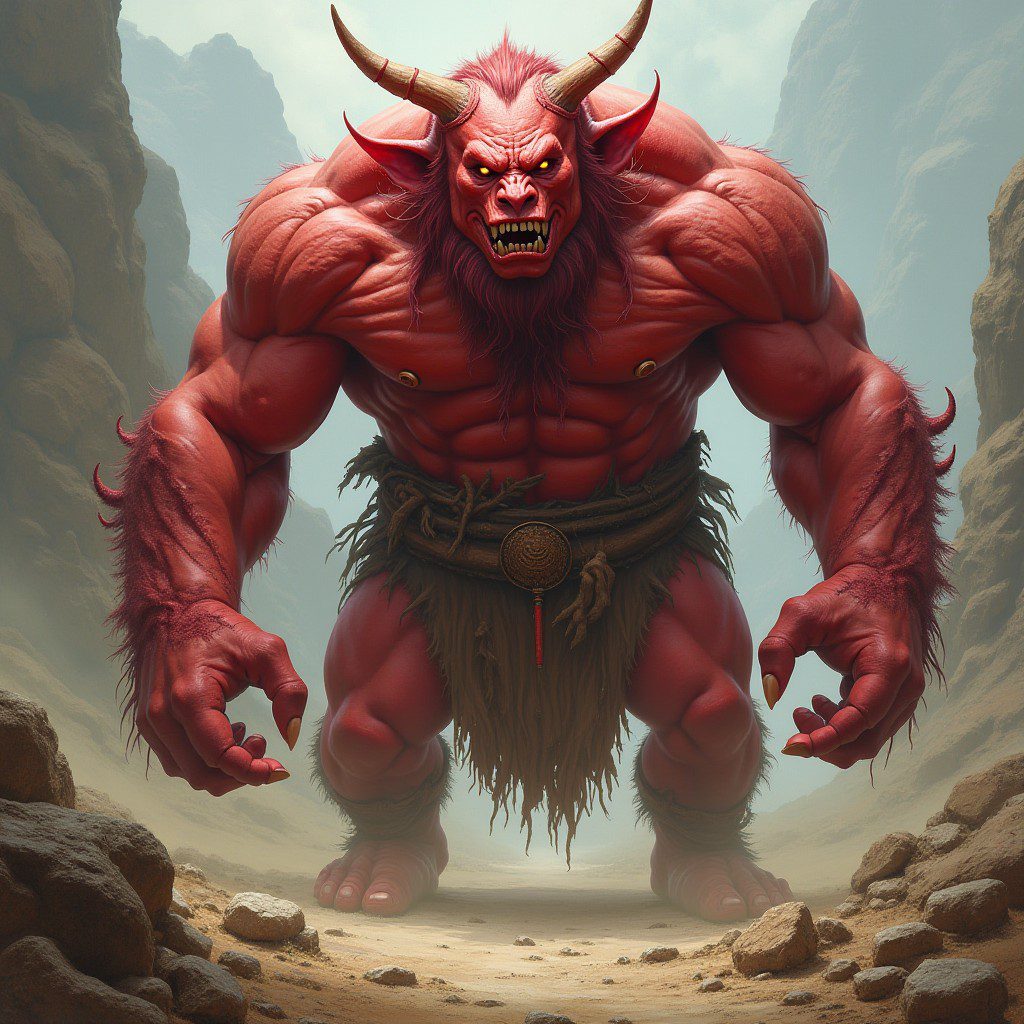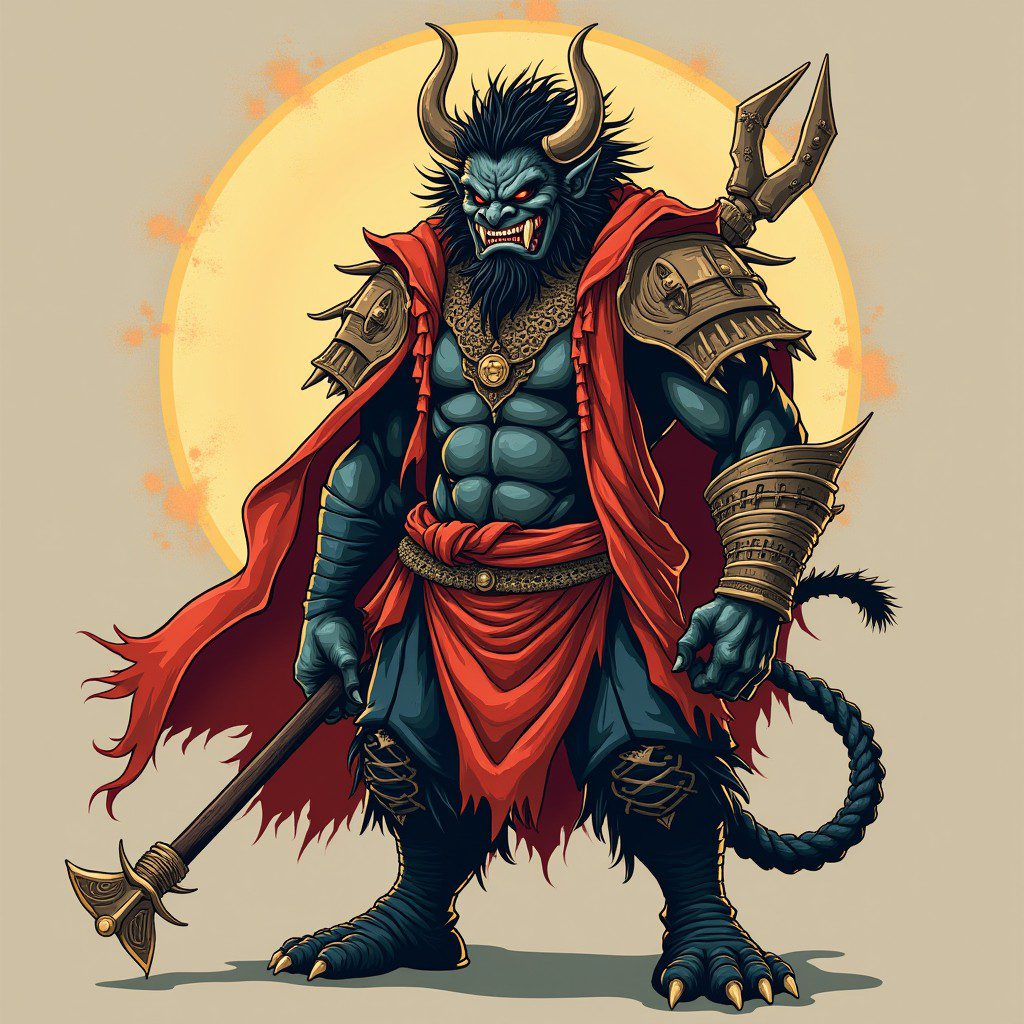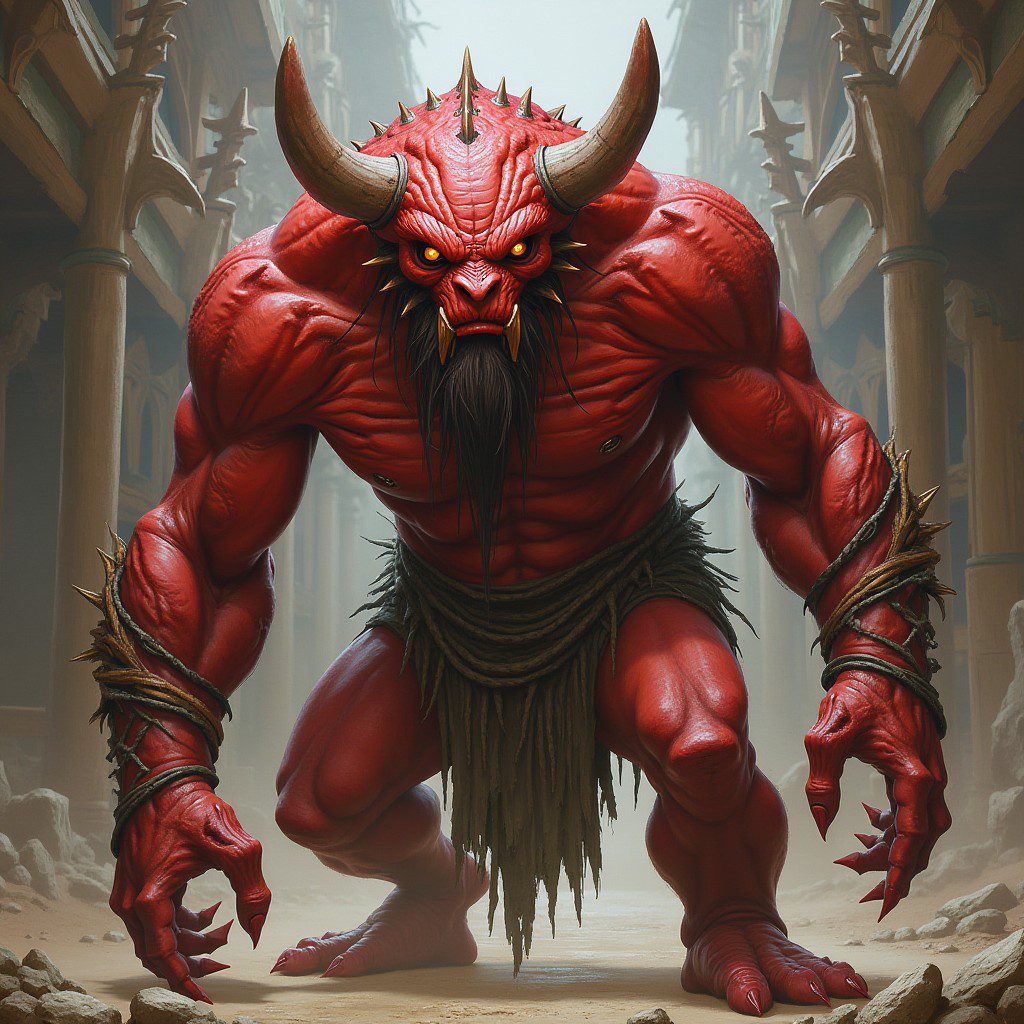Oni: The Fearsome Demons of Japanese Folklore

The Oni are some of the most iconic and terrifying figures in Japanese folklore, often depicted as giant, demonic creatures with immense strength and a penchant for violence and chaos. Oni are traditionally portrayed as malevolent beings, but in some stories, they can be complex characters—either protectors or even tragic figures. With their powerful, otherworldly presence, they have become a staple of Japanese culture, appearing in literature, theater, and modern media, including anime, manga, and video games.
Typically, Oni are characterized by their ferocious appearance, which includes horns, sharp claws, and fearsome faces, often with red or blue skin. They are linked to the concept of evil spirits, demons, or ogres in other cultures, and they often embody chaos, destruction, and punishment.
Origins and Mythological Background
Oni have a deep-rooted presence in Japanese mythology, where they are often seen as symbols of evil or punishment, particularly for those who commit great sins or wrongdoings. Their origins are believed to come from Buddhist and Shinto traditions, where they are described as creatures who punish sinners, especially in the afterlife. However, their image has evolved over centuries, taking on more complex roles and appearances in Japanese storytelling.


1. Buddhist Influence
In Buddhist teachings, Oni serve as enforcers of hell, punishing the wicked and torturing souls who have committed evil deeds in their lifetime. They are often depicted as the torturers of Jigoku, the Buddhist hell, where they carry out punishments on behalf of the underworld’s rulers, such as Enma Daio, the King of Hell. In this role, Oni represent cosmic justice, punishing those who have caused harm during their earthly lives.
2. Shinto Influence
In Shinto belief, Oni can be seen as manifestations of natural disasters, plagues, or other destructive forces. In these stories, they represent the chaotic, uncontrollable side of nature. Sometimes, Oni are believed to be the spirits of people who have died with immense anger or resentment, transforming into these monstrous beings after death.
3. Folk Legends
Oni are a regular feature in Japanese folk tales and legends, where they are often depicted as powerful ogres or demons that terrorize villages, kidnap women, and devour humans. Many stories portray Oni as antagonists that must be outsmarted or defeated by a clever hero. Momotaro (Peach Boy), one of Japan’s most famous folk heroes, is best known for his journey to defeat the Oni on Onigashima (Ogre Island) with the help of animal companions.
Physical Characteristics of Oni
Oni are easily recognizable due to their distinct and intimidating appearance. While their size and features can vary depending on the story, certain characteristics remain consistent:
1. Giant Size and Strength
Oni are often depicted as towering giants, many times larger and stronger than humans. Their immense size and strength make them formidable opponents, and in stories, they are known for their brute force and destructive power. Their size also allows them to wield massive weapons, such as clubs or maces, typically called kanabō (iron clubs).
2. Horns and Fangs
One of the most defining features of Oni is the presence of horns, which protrude from their foreheads. These horns, combined with sharp fangs and claws, give them a distinctly demonic appearance. Oni are sometimes shown with multiple eyes or extra limbs, further emphasizing their otherworldly nature.
3. Red or Blue Skin


Oni are often depicted with bright red or blue skin, although green, black, and yellow Oni are also common in some stories. The color of their skin can sometimes represent their particular role or alignment in the story, with red Oni often portrayed as more aggressive or violent, while blue Oni can be more passive or introspective.
4. Fearsome Faces
Oni are famous for their terrifying faces, which often include large, bulging eyes, snarling mouths full of sharp teeth, and exaggerated facial features. These grotesque features make them instantly recognizable in Japanese art and culture, where their image has become synonymous with fear and danger.
The Role of Oni in Japanese Folklore
In traditional Japanese folklore, Oni are often seen as antagonistic figures, symbolizing evil, destruction, and chaos. However, their roles are not always straightforward, and in some stories, they serve as protectors or tragic figures, providing a more nuanced view of their character.
1. Punishers of the Wicked
Oni are frequently depicted as the enforcers of justice in the afterlife, punishing those who have committed great sins. In this context, Oni are similar to demons or devils in other religious traditions, acting as agents of retribution. They carry out their duties with brutal efficiency, torturing the souls of the wicked in Jigoku (Buddhist hell). In this role, Oni are seen less as evil beings and more as necessary forces of cosmic justice.
2. Monsters to Defeat
In many folk tales, Oni are depicted as monsters or ogres that terrorize humans. These stories often involve a hero who must face the Oni in battle, sometimes defeating the monster through sheer strength, but more often through cleverness and trickery. One of the most famous examples is the story of Momotaro, the Peach Boy, who, along with his animal companions, defeats a group of Oni who have been raiding villages and stealing treasure.
- The Tale of Shuten-dōji: In this famous Japanese legend, Shuten-dōji was a powerful and notorious Oni who terrorized the capital city of Kyoto. Known for kidnapping women and feasting on human flesh, Shuten-dōji and his band of Oni were eventually defeated by the hero Minamoto no Raiko and his warriors, who tricked Shuten-dōji by offering him poisoned sake.
3. Protectors or Guardians
In some stories, Oni are portrayed as protectors or even benevolent beings. Onigawara, for instance, are ornamental roof tiles found on Japanese buildings that feature the face of an Oni. These tiles are meant to ward off evil spirits and protect the structure from harm, suggesting that Oni can also serve a protective role in certain contexts. Similarly, Oni masks are worn during the Japanese festival of Setsubun, where participants throw beans to drive away evil spirits, symbolizing the banishment of misfortune and welcoming good fortune.
4. Tragic Figures
Some more modern interpretations of Oni portray them as tragic figures—creatures that were once human but were transformed into demons due to powerful emotions such as rage, sorrow, or revenge. These stories give Oni more depth, suggesting that they are not purely evil but are driven by overwhelming emotions that lead them to their monstrous state.
A famous variation of this theme is the “Red Oni, Blue Oni” trope, where one Oni represents aggression and violence (Red Oni), while the other symbolizes introspection or sadness (Blue Oni). In some versions of the story, the Red Oni longs for human friendship and is willing to sacrifice its own happiness to maintain peace.
Oni in Modern Media and Pop Culture
Oni have become a common figure in modern Japanese media, including anime, manga, video games, and films. Their fearsome appearance and connection to Japanese culture make them popular antagonists or even anti-heroes in many stories.
1. Anime and Manga
Oni frequently appear in anime and manga, often portrayed as both dangerous and intriguing characters. Their demonic appearance and immense strength make them ideal for combat-driven narratives, but they can also be depicted as complex beings with emotional depth.
- Inuyasha: The anime Inuyasha features several Oni-like demons, with the main character, Inuyasha, being a half-demon who shares some traits with traditional Oni. Many of the series’ villains are inspired by Oni folklore, with monstrous strength and a thirst for power.
- Blue Exorcist: In Blue Exorcist, the protagonist, Rin Okumura, is the son of Satan and possesses traits similar to Oni, such as enhanced strength and blue flames. The show draws heavily from demon mythology, with Oni-inspired characters representing the darker aspects of human nature.
2. Video Games
Oni are common in Japanese video games, where they often appear as powerful enemies or bosses that players must defeat.
- Nioh: In the video game Nioh, Oni are featured prominently as enemies that the player must defeat. These demons take on various forms, from massive, hulking creatures to more humanoid beings, and they are some of the toughest foes in the game.
- Toukiden: The Toukiden series focuses on fighting Oni, known as “Oni-slaying” games. Players take on the role of warriors tasked with defending humanity from Oni invaders, drawing heavily from traditional folklore and mythology for its character designs and storylines.
3. Films and TV
Oni have appeared in a number of Japanese films and television shows, often portrayed as monstrous antagonists or even misunderstood anti-heroes.
- Onibaba: The 1964 Japanese horror film Onibaba tells the story of two women who encounter an Oni mask that brings tragedy and destruction. The film explores the dark side of human nature and the thin line between man and monster, with the Oni mask serving as a metaphor for transformation and corruption.
Strengths and Weaknesses of Oni
Strengths:
- Immense Strength and Size: Oni are known for their immense physical power, often towering over humans and capable of causing massive destruction with their brute force.
- Magical Abilities: Oni often have magical abilities, such as shape-shifting, casting curses, or summoning dark forces. This makes them not only physically powerful but also formidable in supernatural combat.
- Durability: Oni are frequently depicted as nearly invulnerable to conventional weapons, making them difficult to defeat in battle. Their resilience is a key factor in their fearsome reputation.
Weaknesses:
- Cleverness and Trickery: In many folktales, Oni are outwitted by clever heroes who use their intelligence to overcome the Oni’s superior strength. Oni are often portrayed as gullible or susceptible to deception.
- Poison or Magic: Some legends suggest that Oni can be defeated by magical means or by using poison. In the story of Shuten-dōji, for example, the Oni is killed after being tricked into drinking poisoned sake.
- Benevolent Rituals: During certain rituals, such as the Setsubun festival, Oni are driven away by the throwing of beans, a symbolic act meant to cleanse the home of evil spirits. This suggests that Oni can be banished or repelled through spiritual or cultural practices.
The Legacy of Oni in Japanese Culture
Oni remain one of the most enduring and iconic symbols in Japanese folklore, representing the darker side of the supernatural world. Their roles as punishers of evil, chaotic forces of nature, and tragic figures make them complex characters in stories and media. Whether serving as antagonists in folklore or as symbols of protection and justice, Oni continue to captivate audiences with their fearsome power, moral complexity, and deep roots in Japanese tradition.
